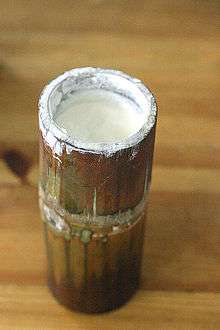Fermented milk products
Fermented milk products or fermented dairy products, also known as cultured dairy foods, cultured dairy products, or cultured milk products, are dairy foods that have been fermented with lactic acid bacteria such as Lactobacillus, Lactococcus, and Leuconostoc. The fermentation process increases the shelf life of the product while enhancing its taste and improving the digestibility of its milk. There is evidence that fermented milk products have been produced since around 10,000 BC.[1] A range of different Lactobacilli strains has been grown in laboratories allowing for many cultured milk products with different flavors and characteristics.

Products
Many different types of cultured milk products can be found around the world including milk, cheese, yogurt, other cultured dairy foods, ice cream and more.[2]
Soured milk
Soured cream
| Country/region of origin | Product(s) |
|---|---|
| cheese | |
| sour cream | |
| Central Asia | kaymak |
| Central & Eastern Europe; and Russia | smetana |
| Croatia | mileram/kiselo vrhnje |
| Finland | kermaviili |
| France | crème fraîche |
| Iceland | sýrður rjómi |
| Hungary | tejföl |
| Latvia | skābais krējums |
| Lithuania | grietinė |
| Mexico | crema/cream espesa |
| Norway | rømme |
| Romania | smântână |
| Serbia | kisela pavlaka |
| Slovakia | smotana |
| Sweden | gräddfil |
| Tanzania | Samli |
Comparison chart
| Product | Alternative names | Typical milkfat content | Typical shelf life at 4 °C | Fermentation agent | Description |
|---|---|---|---|---|---|
| Cheese | 1-75% | varies | a variety of bacteria or mold | Any number of solid fermented milk products. | |
| Crème fraîche | creme fraiche | 30-40% | 10 days[1] | naturally occurring lactic acid bacteria in cream | Mesophilic fermented cream, originally from France; higher-fat variant of sour cream |
| Cultured sour cream | sour cream | 14–40% | 4 weeks[1] | Lactococcus lactis subsp. lactis*[4] | Mesophilic fermented pasteurized cream with an acidity of at least 0.5%. Rennet extract may be added to make a thicker product.[4] Lower fat variant of crème fraîche |
| Filmjölk | fil | 0.1-4.5% | 10–14 days[1] | Lactococcus lactis* and Leuconostoc[5][6] | Mesophilic fermented milk, originally from Scandinavia |
| Yogurt | yoghurt, yogourt, yoghourt | 0.5–4% | 35–40 days[1] | Lactobacillus bulgaricus and Streptococcus thermophilus[4] | Thermophilic fermented milk, cultured with Lactobacillus bulgaricus and Streptococcus thermophilus |
| Kefir | kephir, kewra, talai, mudu kekiya, milkkefir, búlgaros | 0-4% | 10–14 days[1] | Kefir grains, a mixture of bacteria and yeasts | A fermented beverage, originally from the Caucasus region, made with kefir grains; can be made with any sugary liquid, such as milk from mammals, soy milk, or fruit juices |
| Kumis | koumiss, kumiss, kymys, kymyz, airag, chigee | 4%? | 10–14 days[1] | Lactobacilli and yeasts | A carbonated fermented milk beverage traditionally made from horse milk |
| Viili | filbunke | 0.1-3.5% | 14 days[1] | Lactococcus lactis subsp. cremoris, Lactococcus lactis* biovar. diacetylactis, Leuconostoc mesenteroides subsp. cremoris and Geotrichum candidum[7] | Mesophilic fermented milk that may or may not contain fungus on the surface; originally from Sweden; a Finnish specialty[7] |
| Cultured buttermilk | 1–2% | 10 days[1] | Lactococcus lactis*[4] (Lactococcus lactis subsp. lactis*, Lactococcus lactis subsp. cremoris, Lactococcus lactis biovar. diacetylactis and Leuconostoc mesenteroides subsp. cremoris)[1] | Mesophilic fermented pasteurized milk | |
| Acidophilus milk | acidophilus cultured milk | 0.5-2% | 2 weeks[1] | Lactobacillus acidophilus[1][4] | Thermophilic fermented milk, often lowfat (2%, 1.5%) or nonfat (0.5%), cultured with Lactobacillus acidophilus |
* Streptococcus lactis has been renamed to Lactococcus lactis subsp. lactis[8]
References
- "Fermented Milk Products". Canadian Dairy Commission. 2007-06-06. Retrieved 2012-12-26.
- "Dairy Foods & Beverages | Dairy Foods".
- Amilien, Virginie; Torjusen, Hanne; Vittersø, Gunnar (2005-05-04). "From local food to terroir product ? - Some views about Tjukkmjølk, the traditional thick sour milk from Røros, Norway". Anthropology of Food (4). Retrieved 2008-09-04.
- "Newer Knowledge of Dairy Foods: Other: Kinds of Other Dairy Foods". National Dairy Council. Archived from the original on September 25, 2006. Retrieved 2007-06-30.
- "Filmjölk" (in Swedish). Arla Foods. Archived from the original on 2007-08-08. Retrieved 2007-06-29.
- "Ekologisk filmjölk" (in Swedish). Arla Foods. Archived from the original on 2007-08-20. Retrieved 2007-06-30.
- "Viili: the Finnish specialty" (PDF). Valio Foods & Functionals. 2003 (2): 4–5. 2003. Retrieved 2007-06-30.
- Schleifer KH, Kraus J, Dvorak C, Kilpper-Balz R, Collins MD, Fischer W (1985). "Transfer of Streptococcus lactis and related streptococci to the. genus Lactococcus gen. nov". Syst. Appl. Microbiol. 6 (2): 183–195. doi:10.1016/s0723-2020(85)80052-7. ISSN 0723-2020.
External links
| Wikimedia Commons has media related to Fermented milk. |